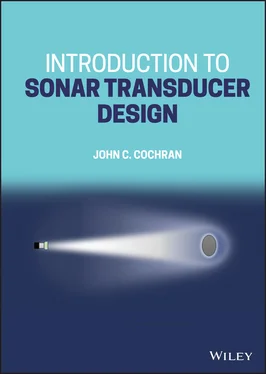John C. Cochran - Introduction to Sonar Transducer Design
Здесь есть возможность читать онлайн «John C. Cochran - Introduction to Sonar Transducer Design» — ознакомительный отрывок электронной книги совершенно бесплатно, а после прочтения отрывка купить полную версию. В некоторых случаях можно слушать аудио, скачать через торрент в формате fb2 и присутствует краткое содержание. Жанр: unrecognised, на английском языке. Описание произведения, (предисловие) а так же отзывы посетителей доступны на портале библиотеки ЛибКат.
- Название:Introduction to Sonar Transducer Design
- Автор:
- Жанр:
- Год:неизвестен
- ISBN:нет данных
- Рейтинг книги:3 / 5. Голосов: 1
-
Избранное:Добавить в избранное
- Отзывы:
-
Ваша оценка:
- 60
- 1
- 2
- 3
- 4
- 5
Introduction to Sonar Transducer Design: краткое содержание, описание и аннотация
Предлагаем к чтению аннотацию, описание, краткое содержание или предисловие (зависит от того, что написал сам автор книги «Introduction to Sonar Transducer Design»). Если вы не нашли необходимую информацию о книге — напишите в комментариях, мы постараемся отыскать её.
A comprehensive introduction to sonar transducer design, complete with real world examples, step-by-step instruction, and detailed mathematical review Introduction to Sonar Transducer Design,
Introduction to Sonar Transducer Design
Introduction to Sonar Transducer Design
Introduction to Sonar Transducer Design — читать онлайн ознакомительный отрывок
Ниже представлен текст книги, разбитый по страницам. Система сохранения места последней прочитанной страницы, позволяет с удобством читать онлайн бесплатно книгу «Introduction to Sonar Transducer Design», без необходимости каждый раз заново искать на чём Вы остановились. Поставьте закладку, и сможете в любой момент перейти на страницу, на которой закончили чтение.
Интервал:
Закладка:
2 Chapter 2Figure 2.2‐1 Mechanical spring‐mass system.Figure 2.2‐2 Mechanical spring‐mass system with losses.Figure 2.2‐3 Behavior of a damped oscillator with Q m= 10 , ω o= 1...Figure 2.2‐4 Mechanical spring‐mass system with losses.Figure 2.2‐5 Spring‐mass system output power vs. frequency.Figure 2.2‐6 Equivalent electrical analog for a spring‐mass system.Figure 2.2‐7 Generators using the mobility and impedance models.Figure 2.2‐8 Series elements in impedance analog.Figure 2.2‐9 Series elements in mobility analog.Figure 2.2‐10 Parallel elements in mobility analog.Figure 2.2‐11 Mechanical spring‐mass system with losses.Figure 2.2‐12 Mechanical spring‐mass system mobility equivalent circuit.Figure 2.2‐13 Mechanical spring‐mass system with losses.Figure 2.2‐14 Mobility equivalent circuit for the mechanical spring‐mass sys...Figure 2.2‐15 Equivalent circuit demonstrating the use of a gyrator.Figure 2.2‐16 Mobility equivalent circuit after transformation across a gyra...Figure 2.2‐17 Equivalent circuit demonstrating conversion from a mobility eq...Figure 2.2‐18 Equivalent circuit demonstrating a converted mobility equivale...Figure 2.2‐19 Equivalent circuit demonstrating conversion from a mobility eq...Figure 2.3‐1 Closed‐end tube acoustic element.Figure 2.3‐2 Open‐ended tube acoustic element.Figure 2.3‐3 Acoustic generators using the mobility and impedance models.Figure 2.3‐4 Pressure equalization orifice as an acoustic element.Figure 2.3‐5 Equivalent circuit for an orifice into a cavity.Figure 2.3‐6 A not‐so‐typical acoustic system to demonstrate an acoustic equ...Figure 2.3‐7 An equivalent circuit for a not‐so‐typical acoustic system.Figure 2.3‐8 Configuration for a cavity resonator.Figure 2.3‐9 Equivalent circuit for a cavity resonator with an orifice.Figure 2.4‐1 A system representing a combination of mechanical and acoustica...Figure 2.4‐2 Equivalent circuit for a mechanical branch of the system using ...Figure 2.4‐3 (Top) Mobility analog and (bottom) impedance analog for the rig...Figure 2.4‐4 Complete impedance analog equivalent circuit for acoustical/mec...Figure 2.5‐1 Two‐port representation of a transducer.Figure 2.5‐2 “ T ” network two‐port equivalent circuit representation of a tra...Figure 2.5‐3 Equivalent circuit representation of a transducer with an elect...Figure 2.5‐4 Two‐port network equivalent of a transducer projector.Figure 2.5‐5 Equivalent circuit representation of a receiver.Figure 2.5‐6 Two‐port representation of a transducer with radiation impedanc...
3 Chapter 3Figure 3.1-1 Geometry of stresses in tensor form.Figure 3.1-2 Geometry of stresses in matrix notation.Figure 3.1-3 A long thin bar with waves traveling within the bar.Figure 3.1-4 Eigenmodes for longitudinal waves in a bar with clamped boundar...Figure 3.1-5 Eigenmodes for longitudinal waves in a bar with free boundary c...Figure 3.1-6 Equivalent circuit representation for longitudinal vibrations i...Figure 3.1-7 Two‐port network for longitudinal vibrations in a bar.Figure 3.1-8 Conditions at end of the bar.Figure 3.1-9 Mass‐loaded bar with one end free.Figure 3.1-10 Equivalent circuit for a mass‐loaded bar with one end free.Figure 3.1-11 Velocity profile in a mass‐loaded bar with one free end and M ...Figure 3.1-12 Velocity profile in a mass‐loaded bar with one free end and M ...Figure 3.1-13 Mass‐loaded bar with one end clamped.Figure 3.1-14 Equivalent circuit for a mass‐loaded bar with one end clamped....Figure 3.1-15 Velocity profile in a mass‐loaded bar with one clamped end and...Figure 3.1-16 Velocity profile in a mass‐loaded bar with one clamped end and...Figure 3.1-17 Distributed equivalent circuit for wave propagation in a bar....Figure 3.1-18 Lumped equivalent circuit for wave propagation in a bar.Figure 3.1-19 Spring/mass model equivalent to the lumped parameter equivalen...Figure 3.1-20 Spring/mass model of a mass‐loaded longitudinal vibrator.Figure 3.1-21 Mass ratio for spring with different load impedances.Figure 3.1-22 The geometry of a hollow cylinder.Figure 3.1-23 Distributed equivalent circuit representation for longitudinal...Figure 3.1-24 Two‐port representation for longitudinal vibrations in a cylin...Figure 3.1-25 Geometry of a conical section.Figure 3.1-26 Geometry of an exponential section.Figure 3.2-1 Illustration of piezo‐electric effect.Figure 3.2-2 Geometry of Hooke’s law and piezo‐electric effect.Figure 3.2-3 Geometry of a 33 mode piezo‐ceramic bar.Figure 3.2-4 Geometry of a 31 mode piezo‐ceramic bar.Figure 3.2-5 Piezo‐electric ceramic material properties matrix shows relevan...Figure 3.3-1 Geometry of a rod and disk piezo‐electric ceramic element.Figure 3.3-2 Geometry of a piezo‐ceramic disk element.Figure 3.3-3 Geometry of a piezo‐ceramic disk element operating in a thickne...Figure 3.3-4 An equivalent circuit for a piezo‐electric ceramic disk transdu...Figure 3.3-5 Geometry of a piezo‐ceramic rod element.Figure 3.3-6 An equivalent circuit for a piezo‐electric ceramic bar transduc...Figure 3.3-7 Frequency constants for coupled fundamental modes in a piezo‐ce...Figure 3.3-8 Geometry for piezo‐ceramic parallelepipeds.Figure 3.3-9 Geometry for piezo‐ceramic 31 mode parallelepiped with one larg...Figure 3.3-10 Equivalent circuit for a 31 mode length expander bar with elec...Figure 3.3-11 Geometry for piezo‐ceramic 33 mode parallelepiped with one lar...Figure 3.3-12 Equivalent circuit for a 33 mode length expander bar with elec...Figure 3.3-13 Geometry for piezo‐ceramic “33” mode parallelepiped with large...Figure 3.3-14 Equivalent circuit for thickness mode vibrations in thin plate...Figure 3.3-15 Geometry for piezo‐ceramic parallelepiped with one large dimen...Figure 3.3-16 Resonances for parallelepiped of PZT‐4 with one large dimensio...Figure 3.3-17 Geometry for piezo‐ceramic parallelepiped with one small dimen...Figure 3.3-18 Resonances for parallelepiped of PZT‐4 with one small dimensio...Figure 3.3-19 Geometry for piezo‐ceramic parallelepiped with one small dimen...Figure 3.3-20 Resonances for parallelepiped of PZT‐4 with one small dimensio...Figure 3.3-21 Geometry for general piezo‐ceramic parallelepiped.Figure 3.3-22 Resonances for parallelepiped of PZT‐4 with applied field para...Figure 3.3-23 A tonpilz transducer using piezo‐electric ceramic cylinders as...Figure 3.3-24 Geometry of an axially polarized piezo‐electric ceramic cylind...Figure 3.3-25 An equivalent circuit for length longitudinal mode vibrations ...Figure 3.3-26 Frequency constants for coupled modes in a piezo‐electric, thi...Figure 3.3-27 Geometry of a radially polarized piezo‐electric ceramic cylind...Figure 3.3-28 An equivalent circuit for length longitudinal mode vibrations ...Figure 3.3-29 Frequency constants for longitudinal modes in a piezo‐electric...Figure 3.3-30 Geometry of a radially polarized piezo‐electric ceramic cylind...Figure 3.3-31 An equivalent circuit for radial vibrations in a piezo‐electri...Figure 3.3-32 Geometry of a radially polarized segmented piezo‐electric cera...Figure 3.3-33 An equivalent circuit for length longitudinal mode of a piezo‐...Figure 3.3-34 Frequency constants for longitudinal modes in a piezo‐electric...Figure 3.3-35 An equivalent circuit for radial vibrations in a piezo‐electri...Figure 3.3-36 Geometry for the spherical radiator.Figure 3.3-37 Equivalent circuit for the piezo‐ceramic sphere.
4 Chapter 4Figure 4.1‐1 The tonpilz projector transducer represents one of the more com...Figure 4.1‐2 A two‐port network for non‐piezoelectric elements.Figure 4.1‐3 A series combination of two‐port networks for non‐piezoelectric...Figure 4.1‐4 A parallel combination of two‐port networks for non‐piezoelectr...Figure 4.1‐5 A series combination of two‐port networks for piezoelectric ele...Figure 4.1‐6 Typical transducer ladder network.Figure 4.1‐7 Ladder network series termination.Figure 4.1‐8 Ladder network parallel termination.Figure 4.1‐9 Ladder network termination.Figure 4.1‐10 Ladder network termination.Figure 4.2‐1 Projector technology for different frequency ranges.Figure 4.2‐2 Geometry for the spherical radiator.Figure 4.2‐3 An equivalent circuit for the spherical projector (top) showing...Figure 4.2‐4 The ratio of in‐water to in‐air resonant frequency for a spheri...Figure 4.2‐5 Q mvs. mean diameter‐to‐wall thickness ratio.Figure 4.2‐6 Transmitting Voltage Response ( TVR ) for a lossless, air‐backed ...Figure 4.2‐7 An equivalent circuit for the spherical projector showing mecha...Figure 4.2‐8 The fluid‐filled spherical projector.Figure 4.2‐9 An equivalent circuit for the spherical projector showing compl...Figure 4.2‐10 The impact of a castor oil fill fluid on the resonance frequen...Figure 4.2‐11 The radially polarized cylindrical projector.Figure 4.2‐12 Equivalent circuit model for a radially polarized cylindrical ...Figure 4.2‐13 The ratio of in‐water to in‐air resonant frequency for a cylin...Figure 4.2‐14 Q mvs. mean diameter‐to‐wall thickness ratio.Figure 4.2‐15 Source level for an air‐backed cylinder projector vs. piezo‐ce...Figure 4.2‐16 Geometry of fiber‐wrapped cylinder.Figure 4.2‐17 Beam pattern for a cylinder with kL = 6 π .Figure 4.2‐18 TVR for an air‐backed cylindrical projector example.Figure 4.2‐19 The radially polarized cylindrical projector with interior flu...Figure 4.2‐20 Equivalent circuit model for a radially polarized cylindrical ...Figure 4.2‐21 Fluid‐filled/air‐backed resonance frequency.Figure 4.2‐22 A squirter cylindrical radiator in a baffle.Figure 4.2‐23 Beam patterns for the radially polarized, squirter cylindrical...Figure 4.2‐24 A squirter cylindrical radiator equivalent circuit.Figure 4.2‐25 The TVR of a squirter cylindrical radiator. The in‐water reson...Figure 4.2‐26 The free‐flooded, radially polarized, cylindrical projector.Figure 4.2‐27 Radiation from the free‐flooded, radially polarized, cylindric...Figure 4.2‐28 Beam patterns for the free‐flooded, radially polarized, cylind...Figure 4.2‐29 The TVR of a radially polarized, free‐flooded cylindrical radi...Figure 4.2‐30 The free‐flooded, radially polarized, cylindrical projector wi...Figure 4.2‐31 Beam patterns for the free‐flooded, radially polarized, cylind...Figure 4.2‐32 The TVR of a radially polarized, free‐flooded cylindrical radi...Figure 4.2‐33 The barrel stave projector.Figure 4.2‐34 The barrel stave projector equivalent circuit.Figure 4.2‐35 The TVR of a circumferentially polarized, air‐backed cylindric...Figure 4.2‐36 Beam patterns for the free‐flooded, circumferentially polarize...Figure 4.2‐37 The TVR of a circumferentially polarized, free‐flooded cylindr...Figure 4.2‐38 A circumferentially polarized “striped” cylinder.Figure 4.2‐39 (Top) The electric field lines for a circumferentially polariz...Figure 4.2‐40 Geometry of electric field lines in a striped cylinder.Figure 4.2‐41 Effect of stripe spacing‐to‐cylinder thickness ratio on effect...Figure 4.2‐42 Effect of stripe width‐to‐stripe spacing ratio on effective co...Figure 4.2‐43 Effect of stripe width‐to‐cylinder thickness ratio on effectiv...Figure 4.2‐44 A tonpilz transducer.Figure 4.2‐45 A simple tonpilz transducer used for example.Figure 4.2‐46 The equivalent circuit for a simple tonpilz transducer example...Figure 4.2‐47 Transmit voltage response ( TVR ) for a simple tonpilz transduce...Figure 4.2‐48 A nodal mounted tonpilz transducer used for example.Figure 4.2‐49 Transmit voltage response ( TVR ) for a simple nodal mounted ton...Figure 4.2‐50 The trilaminar flexural disk assembly.Figure 4.2‐51 The trilaminar flexural disk assembly in a housing.Figure 4.2‐52 The trilaminar flexural disk assembly showing the edge moment Figure 4.2‐53 Deflection profile for the trilaminar flexural disk assembly, ...Figure 4.2‐54 Details of the trilaminar flexural disk assembly showing bendi...Figure 4.2‐55 Effective coupling coefficient for the trilaminar flexural dis...Figure 4.2‐56 Flexural disk in‐air resonance frequency constant ( f r d ) pl...Figure 4.2‐57 The radiation mass factor  is plotted against the Normalized ...Figure 4.2‐58 Flexural disk in‐water resonance frequency constant ( f w d ) ...Figure 4.2‐59 The trilaminar flexural disk mechanical Q Mplotted as a fun...Figure 4.2‐60 Mechanical compliance of the trilaminar flexural disk plotted ...Figure 4.2‐61 Equivalent electrical circuit for the trilaminar flexural disk...Figure 4.2‐62 TVR for the trilaminar flexural disk transducer with different...Figure 4.2‐63 The bilaminar flexural disk assembly.Figure 4.2‐64 Details of the bilaminar flexural disk assembly showing bendin...Figure 4.2‐65 Effective coupling coefficient for the bilaminar flexural disk...Figure 4.2‐66 Flexural disk in‐air resonance frequency constant ( f r d ) pl...Figure 4.2‐67 Flexural disk in‐water resonance frequency constant ( f w d ) ...Figure 4.2‐68 Flexural disk mechanical Q mplotted as a function of total ...Figure 4.2‐69 Mechanical compliance of the bilaminar flexural disk plotted a...Figure 4.2‐70 TVR for a bilaminar flexural disk transducer with different bo...Figure 4.2‐71 Flat oval flextensional transducer.Figure 4.2‐72 Various flat oval flextensional transducers.Figure 4.2‐73 Illustration showing out‐of‐phase displacements in Class IV fl...Figure 4.2‐74 The tapered wall‐slotted cylinder projector (SCP).Figure 4.2‐75 Cross sectional view of the tapered wall SCP defined by a set ...Figure 4.2‐76 Piezo‐ceramic/shell assembly section showing strain under an a...Figure 4.2‐77 Normalized displacement profiles with comparison to same from ...Figure 4.2‐78 Example of in‐air resonance frequency as a function of shell a...Figure 4.2‐79 Example of effective electromechanical coupling for an SCP as ...Figure 4.2‐80 An equivalent circuit representation of a single degree of fre...Figure 4.2‐81 Example of the in‐water resonant frequency as a function of sh...Figure 4.2‐82 Example of the in‐water
is plotted against the Normalized ...Figure 4.2‐58 Flexural disk in‐water resonance frequency constant ( f w d ) ...Figure 4.2‐59 The trilaminar flexural disk mechanical Q Mplotted as a fun...Figure 4.2‐60 Mechanical compliance of the trilaminar flexural disk plotted ...Figure 4.2‐61 Equivalent electrical circuit for the trilaminar flexural disk...Figure 4.2‐62 TVR for the trilaminar flexural disk transducer with different...Figure 4.2‐63 The bilaminar flexural disk assembly.Figure 4.2‐64 Details of the bilaminar flexural disk assembly showing bendin...Figure 4.2‐65 Effective coupling coefficient for the bilaminar flexural disk...Figure 4.2‐66 Flexural disk in‐air resonance frequency constant ( f r d ) pl...Figure 4.2‐67 Flexural disk in‐water resonance frequency constant ( f w d ) ...Figure 4.2‐68 Flexural disk mechanical Q mplotted as a function of total ...Figure 4.2‐69 Mechanical compliance of the bilaminar flexural disk plotted a...Figure 4.2‐70 TVR for a bilaminar flexural disk transducer with different bo...Figure 4.2‐71 Flat oval flextensional transducer.Figure 4.2‐72 Various flat oval flextensional transducers.Figure 4.2‐73 Illustration showing out‐of‐phase displacements in Class IV fl...Figure 4.2‐74 The tapered wall‐slotted cylinder projector (SCP).Figure 4.2‐75 Cross sectional view of the tapered wall SCP defined by a set ...Figure 4.2‐76 Piezo‐ceramic/shell assembly section showing strain under an a...Figure 4.2‐77 Normalized displacement profiles with comparison to same from ...Figure 4.2‐78 Example of in‐air resonance frequency as a function of shell a...Figure 4.2‐79 Example of effective electromechanical coupling for an SCP as ...Figure 4.2‐80 An equivalent circuit representation of a single degree of fre...Figure 4.2‐81 Example of the in‐water resonant frequency as a function of sh...Figure 4.2‐82 Example of the in‐water  as a function of shell taper paramet...Figure 4.2‐83 TVR and admittance ( G, C p), for example, tapered wall SCP t...Figure 4.2‐84 A cross sectional view of a moving coil transducer.Figure 4.2‐85 An equivalent circuit model for a moving coil transducer.Figure 4.2‐86 The performance of a simplified example of a moving coil trans...Figure 4.2‐87 The line‐in‐cone directional transducer.Figure 4.2‐88 The aperture function for the line‐in‐cone directional transdu...Figure 4.2‐89 The beam pattern typical for the line‐in‐cone directional tran...Figure 4.2‐90 An assemblage of λ /4 resonator rods.Figure 4.2‐91 A λ /4 resonator assembly – courtesy Raytheon Company.Figure 4.2‐92 An equivalent circuit for an assemblage of λ /4 resonator ...Figure 4.2‐93 A simplified equivalent circuit for an assemblage of λ /4 ...Figure 4.2‐94 Acoustic performance of a quarter‐wavelength resonator assembl...Figure 4.2‐95 Beam pattern, for example, quarter‐wavelength resonator assemb...Figure 4.2‐96 An example disk projector.Figure 4.2‐97 A simplified equivalent circuit, for example, disk projector....Figure 4.2‐98 Acoustic performance of a disk resonator.Figure 4.2‐99 Beam pattern, for example, disk resonator assembly.Figure 4.2‐100 HF line element in a soft baffle.Figure 4.2‐101 Beam pattern for aperture of dimensions W and L in a soft baf...Figure 4.3‐1 A simplified equivalent circuit for a piezo‐ceramic projector....Figure 4.3‐2 Impact of k effon the bandwidth of a transducer TVR .Figure 4.3‐3 An equivalent circuit for assessing the impact of λ /4 matc...Figure 4.3‐4 Impact of λ /4 matching layers with different ρc chara...Figure 4.3‐5 Equivalent circuit for evaluating power limitations of sonar tr...Figure 4.3‐6 Equivalent circuit for evaluating loss‐related power limitation...Figure 4.3‐7 Geometry for thermal limitation problem.Figure 4.3‐8 Heat‐generation pulse train.Figure 4.3‐9 Temperature rise for a nonsteady‐state pulsed transducer.Figure 4.3‐10 The ratio of the maximum steady state hot spot temperature ris...Figure 4.3‐11 Cavitation intensity vs. frequency and depth.Figure 4.3‐12 Impact of fluid viscosity on cavitation intensity vs. frequenc...
as a function of shell taper paramet...Figure 4.2‐83 TVR and admittance ( G, C p), for example, tapered wall SCP t...Figure 4.2‐84 A cross sectional view of a moving coil transducer.Figure 4.2‐85 An equivalent circuit model for a moving coil transducer.Figure 4.2‐86 The performance of a simplified example of a moving coil trans...Figure 4.2‐87 The line‐in‐cone directional transducer.Figure 4.2‐88 The aperture function for the line‐in‐cone directional transdu...Figure 4.2‐89 The beam pattern typical for the line‐in‐cone directional tran...Figure 4.2‐90 An assemblage of λ /4 resonator rods.Figure 4.2‐91 A λ /4 resonator assembly – courtesy Raytheon Company.Figure 4.2‐92 An equivalent circuit for an assemblage of λ /4 resonator ...Figure 4.2‐93 A simplified equivalent circuit for an assemblage of λ /4 ...Figure 4.2‐94 Acoustic performance of a quarter‐wavelength resonator assembl...Figure 4.2‐95 Beam pattern, for example, quarter‐wavelength resonator assemb...Figure 4.2‐96 An example disk projector.Figure 4.2‐97 A simplified equivalent circuit, for example, disk projector....Figure 4.2‐98 Acoustic performance of a disk resonator.Figure 4.2‐99 Beam pattern, for example, disk resonator assembly.Figure 4.2‐100 HF line element in a soft baffle.Figure 4.2‐101 Beam pattern for aperture of dimensions W and L in a soft baf...Figure 4.3‐1 A simplified equivalent circuit for a piezo‐ceramic projector....Figure 4.3‐2 Impact of k effon the bandwidth of a transducer TVR .Figure 4.3‐3 An equivalent circuit for assessing the impact of λ /4 matc...Figure 4.3‐4 Impact of λ /4 matching layers with different ρc chara...Figure 4.3‐5 Equivalent circuit for evaluating power limitations of sonar tr...Figure 4.3‐6 Equivalent circuit for evaluating loss‐related power limitation...Figure 4.3‐7 Geometry for thermal limitation problem.Figure 4.3‐8 Heat‐generation pulse train.Figure 4.3‐9 Temperature rise for a nonsteady‐state pulsed transducer.Figure 4.3‐10 The ratio of the maximum steady state hot spot temperature ris...Figure 4.3‐11 Cavitation intensity vs. frequency and depth.Figure 4.3‐12 Impact of fluid viscosity on cavitation intensity vs. frequenc...
Интервал:
Закладка:
Похожие книги на «Introduction to Sonar Transducer Design»
Представляем Вашему вниманию похожие книги на «Introduction to Sonar Transducer Design» списком для выбора. Мы отобрали схожую по названию и смыслу литературу в надежде предоставить читателям больше вариантов отыскать новые, интересные, ещё непрочитанные произведения.
Обсуждение, отзывы о книге «Introduction to Sonar Transducer Design» и просто собственные мнения читателей. Оставьте ваши комментарии, напишите, что Вы думаете о произведении, его смысле или главных героях. Укажите что конкретно понравилось, а что нет, и почему Вы так считаете.












![John Ruskin - Stones of Venice [introductions]](/books/732383/john-ruskin-stones-of-venice-introductions-thumb.webp)